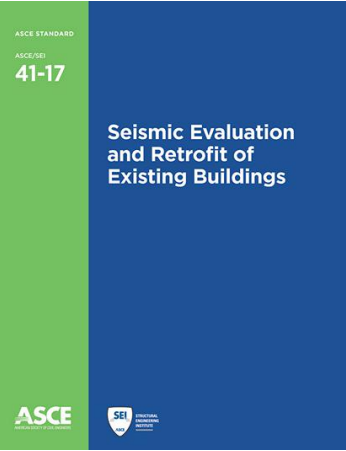What you always wanted to ask.
This quarterly article addresses some of the questions received about structural standards developed by the Structural Engineering Institute (SEI) of the American Society of Civil Engineers (ASCE). In addition, questions from engineers, building officials, and other design professionals are often considered to develop future editions. Following are some questions received by SEI and responses to clarify the provisions.
ASCE 41, ASCE 7, Fv, And Supplements
I have realized that there are corrections for the Fv values in ASCE 7-16 that have been provided in additional supplements, particularly with Supplement 1 and Supplement 3. Since ASCE 41 relies on these values from ASCE 7, how does one find the correct values now in ASCE 41?
Fortunately, the ASCE 41 committee has addressed this and also published a correction. Supplement 1 to ASCE 41-17 adopts Supplements 1 and 3 of ASCE 7-16. To expand on the explanation, changes were made to ASCE 7-16 near the end of the cycle, creating a situation where one could not develop the general response spectrum for the Basic Safety Earthquake 1 and 2 (BSE-1E and BSE-2E) on Site Class E because there is no Fv value for Site Class E in ASCE 7-16. To address this, Fv values were provided in ASCE 7-16 Supplement 1. Supplement 1 also contains modifications to Chapter 21 of ASCE 7-16, the site-specific hazard procedures. Supplement 3 of ASCE 7-16 changes the exception to Section 11.4.8 of ASCE 7, which permits users to use the general response spectra with a modified SD1 value as opposed to a site-specific spectrum when situated on Site Class D and E. The original exception required Cs multiplied by 1.5. Because there is no Cs in ASCE 41, one could use the exception without amplifying the BSE-1N and BSE-2N SX1 parameter by 1.5, which is the intent of the exception. Supplement 3 revises the exemption to require the SD1 parameter to be multiplied by 1.5.
This is explained fully in the commentary in ASCE 41-17 Supplement 1 Chapter C2 SEISMIC HAZARD as follows:
In ASCE 7-16, a provision was added requiring site-specific procedures be used to develop the BSE-1N and BSE-2N hazard parameters or amplification factors on the USGS mapped values be used when a building is on Site Class D or E. Supplement 1 of this standard adopts two supplements of ASCE 7-16 related to this and clarifies that user of this standard would apply the site-specific rules or the appropriate amplification factors to the BSE-1N and BSE-2N hazards as indicated in ASCE 7-16, but that those rules do not apply to the BSE-1E and BSE-2E hazards. While the modified, larger Fa and Fv values for determining the lower limit on site-specific procedures in ASCE 7 Section 21.3 are required for the BSE-1N and BSE-2N, they are not for other seismic hazard levels. This is because the modified, larger Fa and Fv values were developed to correct for the non-conservatism of the 1/T spectral shape at the BSE-2N seismic hazard level for Site Classes D and E. These Fa and Fv values were not developed for other, lower seismic hazard levels, such as the BSE-1E and BSE-2E. Therefore, for other hazard levels, the Fa and Fv values per Chapter 11 of ASCE 7 are referenced instead.
The full text of ASCE 41-17 Supplement 1 can be found in the ASCE Library or on www.asce.org/sei.
Flexural Rigidity For Walls
In ASCE 41-17, Table 10-5 Effective Stiffness Values, the equation for Flexural rigidity in Walls-Cracked includes gross Area (Ag). The stiffness for flexural members is not calculated with the area; is this correct?
You are correct; flexural rigidity is calculated using the gross moment of inertia of the gross section, Ig, and should be 0.35EcEIg. This was corrected in published errata in Batch 1, published Dec. 3, 2018. This, along with Batch 2 and 3 of the published errata, is available in the ASCE Library or on www.asce.org/sei.

ASCE 41-23
When will the 2023 edition of ASCE 41 be published? Will it be referenced into the 2024 International Existing Building Code?
The 2023 edition of ASCE 41 was published in December of 2023 and is available at www.asce.org. ASCE 41-23 was approved for adoption into the 2024 IEBC, however was erroneously omitted during publishing and now appears as an errata in ICC Errata Central and will be corrected when the 2nd edition of the 2024 IEBC is printed.
This article’s information is provided for general informational purposes only and is not intended in any fashion to be a substitute for professional consultation. The information provided does not constitute a formal interpretation of the standard. Under no circumstances does ASCE/SEI, its affiliates, officers, directors, employees, or volunteers warrant the completeness, accuracy, or relevancy of any information or advice provided herein or its usefulness for any particular purpose. ASCE/SEI, its affiliates, officers, directors, employees, and volunteers expressly disclaim any and all responsibility for any liability, loss, or damage that you may cause or incur in reliance on any information or advice provided herein.
If you have a question you want to be considered in a future issue, please send it to sei@asce.org with FAQ in the subject line. Visit asce.org/sei to learn more about ASCE/SEI Standards.■
